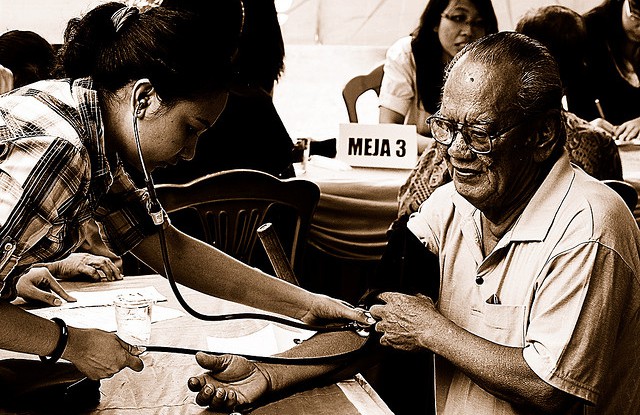BOGOR, Indonesia (14 March, 2012)_CIFOR has already devoted some of its research effort to looking at the health of people in forests, but considerations of remoteness and inadequate health care services can affect researchers as well, as shown in this excerpt from Vignettes from a Year in Borneo.
Even before moving to Danau Sentarum, I was plagued with a new and strange sense of impending doom—not about the project, but about our private lives. As our arrival date approached, and as we settled in, the fear increased, particularly about my son. I imagined he would fall from the boardwalks and break something, that he would be bitten by a poisonous snake or a crocodile, that he would hit his head falling off a raft and drown. I also imagined that Dudley or I would have a heart attack or some other medical emergency. I puzzled over these uncharacteristic concerns. I was used to meeting new situations with a certain degree of equanimity.
Soon after we arrived in Ng. Pengembung, ‘Alan indeed fell. Balancing on a plank en route to a raft, he was pulled into the water when his cast net caught on a snag. He had what looked like a nasty bruise—along with a bruised ego, because the man with whom he’d been fishing laughed at his tears. Dudley left on a trip to Pontianak, and ‘Alan’s bruise turned into a festering sore. In a few days, his whole leg had swelled up, like a balloon, he came down with a raging fever, and eventually couldn’t even walk.
We had the worst night I ever hope to have with him. He lay in Dudley’s place on our mattresses, and I sponged him off with cool rags and alcohol, trying to make him more comfortable. He is normally rather oblivious to pain, so his occasional low moan pierced my heart. I knew he was hurting, and I kept wondering how I would ever forgive myself if he died in this remote place where I had brought him.
I put him on antibiotics, and decided I had to take him to the doctor in Suhaid—but our speedboat had not yet returned from the trip to Sintang, with Dudley. I made ‘Alan as comfortable as possible in a longboat, and hired someone to take us to the doctor. When we got to Suhaid, two hours later, we discovered that the clinic was at the top of what, at the height of the dry season, had become an imposing cliff— and my 100 pound son couldn’t walk. The doctor refused to come down. Finally a slim young man in a nearby bandung kindly offered to carry him up the treacherous slope (including tippy planks, slippery mud, and rickety ladders!). I watched in fear and gratitude, as the man, roughly ‘Alan’s height but of wiry build, kindly scrambled up (and later, down) the cliff with my child on his back.
When we got to the doctor, he wanted to give ‘Alan a penicillin shot (the standard solution for most ailments in Indonesia), and in retrospect, I suppose I should have let him. He argued that the oral Amoxicillin I’d given wasn’t as good for this problem, but when I continued to resist he agreed that Amoxicillin would probably work.
My new-found fearfulness was in full swing: I was afraid of dirty needles, and HIV/AIDS, and I still had a lingering fear that ‘Alan might be allergic to penicillin. The doctor’s recommendations differed from those in our book, Where There is no Doctor, and I, sadly, had more faith in the book than in Indonesian medical training. ‘Alan was on medication for nearly two months, trying to keep his leg dry (a virtual impossibility in our riverine existence). His wound finally healed in November, leaving a nasty scar still visible on his shin.
Vignettes of a year in Borneo is a personal account of my life in the middle of Borneo, as a family, working on the first year and a half of a Conservation Project. The book publisher has set aside some of the sales proceeds to support Riak Bumi, a West Kalimantan-based NGO that focuses on conservation and community welfare and works within the communities living in and around Danau Sentarum.
To purchase your copy and contribute to Riak Bumi’s action, click here.
We want you to share Forests News content, which is licensed under Creative Commons Attribution-NonCommercial-ShareAlike 4.0 International (CC BY-NC-SA 4.0). This means you are free to redistribute our material for non-commercial purposes. All we ask is that you give Forests News appropriate credit and link to the original Forests News content, indicate if changes were made, and distribute your contributions under the same Creative Commons license. You must notify Forests News if you repost, reprint or reuse our materials by contacting forestsnews@cifor-icraf.org.

